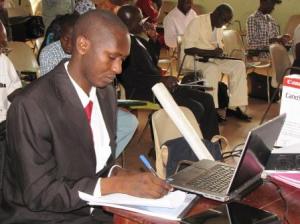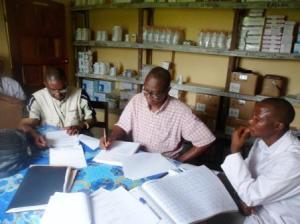By Luciana Maxim, SIAPS Technical Consultant; Marie Paule Fargier, SIAPS Country Project Director; and Serigne Diagne, SIAPS Project Director
Prior to 2013, Guinea’s public health facilities faced prolonged stock-outs of antimalarial medicines and health commodities. This was due in part to a shortage of products in the country, but also resulted from substandard reporting of data on stock status and consumption of malaria commodities to the National Malaria Control Program (PNLP). Without this information, quantifying the national and local needs for malaria medicines and rapid diagnostic tests was extremely difficult, fueling a vicious cycle of more stock-outs and unreliable data.
Implementing solutions for information challenges
Starting in 2012 with an initial assessment, the Systems for Improved Access to Pharmaceuticals and Services (SIAPS) program, funded by the US Agency for International Development (USAID) and the President’s Malaria Initiative (PMI), worked closely with PNLP and a wide range of stakeholders to redesign the data collection forms used at the health facility level and simplify the process of submitting monthly malaria reports from the district level to the Ministry of Health. The malaria reporting template now includes new sections on pharmaceutical management and malaria diagnosis and treatment to allow for more rigorous monitoring of commodities and patient care.

SIAPS trained heads of health centers, pharmacists, and data managers in the 19 districts supported by USAID and PMI on the use of the new form in July 2013, providing each district with internet keys and monthly credit to pilot electronic, email-based reporting. Acting on a SIAPS recommendation, PNLP initiated quarterly malaria review meetings at the regional level and a performance-based reporting competition among the districts, awarding much-needed IT equipment (e.g. laptops, printers, and scanners) to the winners.
Scaling up what works
In just over one year, reporting rates in the PMI-supported districts improved dramatically—from approximately 30% in 2012 to an average of 96% for the first nine months of 2014. Importantly, use of email for reporting led to an increase in on-time submissions. Approximately 88% of the monthly reports submitted in 2014 have arrived on time. Based on the initial success, the new reporting process has been adopted by PNLP and CRS (the Global Fund principal recipient for malaria in Guinea) in the 19 Global Fund-supported districts, leading to a unified malaria reporting mechanism across the country. SIAPS shared lessons learned and provided technical assistance for the trainings conducted in the Global Fund-supported zones.

Going back to the source
One of the remaining challenges is improving data quality and reliability. Over the past year, PNLP and SIAPS have provided detailed feedback to health districts on their reports and held refresher trainings at quarterly review meetings. The most recent end-use verification (EUV) survey conducted by the Ministry of Health and SIAPS in July 2014 showed that districts have increased feedback to their facilities—100% of facilities sampled in PMI zones in July 2014 had received feedback, up from 35% of facilities sampled in April 2013, before the intervention. While the quality of data submitted appears to be improving, the next step will be to identify and correct issues related to data validity directly at the facility level. PNLP, SIAPS, and the Stop Palu project have initiated joint supervisions to verify whether the reports submitted match the source documents (patient registers and stock cards) and identify whether these source documents were completed appropriately.
Using data to inform and enable better decision-making
Over the past year, SIAPS has provided technical assistance to PNLP to create templates to aggregate data from the monthly reports. The resulting information has enabled, among other things, a quantification of malaria commodities distributed to regional warehouses in April 2014, based on prior consumption patterns. Going forward, SIAPS will work with PNLP to establish a routine process for data aggregation, analysis, and dissemination through a regular newsletter.
Beyond malaria: Building a strong pharmaceutical information system
In parallel with the malaria reporting activities, SIAPS has helped establish a pilot pharmaceutical information system for maternal and child health commodities at the community level. SIAPS is also engaged in discussions with key national priority disease programs, the Medicines Regulatory Authority, and various health partners to implement a comprehensive Pharmaceutical Management Information System (PMIS), in order to improve the forecasting, procurement, and distribution of all essential medicines in Guinea. The PMIS will initially focus on malaria, family planning, and maternal and child health commodities, and eventually will be expanded to integrate HIV, tuberculosis, and other commodities.

